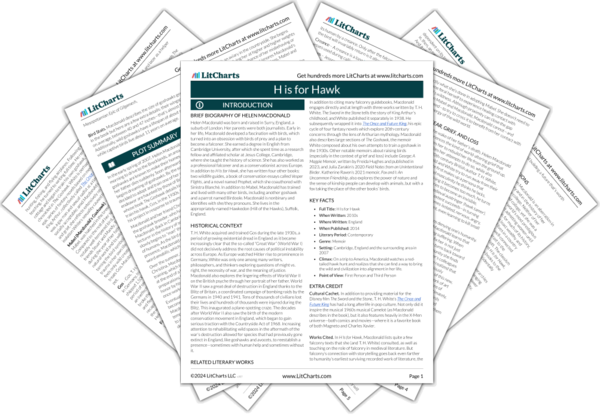Creance Quotes in H is for Hawk
As a child I learned to love falconry’s disconcertingly complex vocabulary. In my old books every part of a hawk was named: wings were sails, claws pounces, tail a train. Male hawks are a third smaller than the female so they are called tiercels, from the Latin tertius, for third. Young birds are eyasses, older birds passagers, adult-trapped birds haggards. Half-trained hawks fly on a long line called a creance. Hawks don’t wipe their beaks, they feak. When they defecate they mute. [...] On and on it goes in a dizzying panoply of terms of precision. The terms were precise for a reason. Knowing your falconry terminology attested to your place in society. […] But the words weren’t about social fear when I was small. They were magic words, arcane and lost. I wanted to master this world that no one knew, to be an expert in its perfect, secret language.
It’s a sad picture. It reminds me of a paper by the psychoanalyst D. W. Winnicott, the one about a child obsessed with string; a boy who tied together chairs and tables, tied cushions to the fireplace, even, worryingly, tied string around his sister’s neck. Winnicott saw this behaviour as a way of dealing with fears of abandonment by the boy’s mother, who’d suffered bouts of depression. For the boy, the string was a kind of wordless communication, a symbolic means of joining. It was a denial of separation. Holding tight. Perhaps those jesses might have been unspoken attempts to hold onto something that had already flown away. […] I had a twin brother. He didn’t [survive …] When I found out about my twin many years later, the news was surprising. But not so surprising. I’d always felt a part of me was missing […]
I stood there, raised my arm, and whistled the whistle that meant, Please come. This is where you want to be. Fly to me. Ignore the towering clouds, the wind that pushes the trees behind you. Fix yourself on me and fly between where you are and where I am. […] I’d see her drop from the perch, speed towards me, and my heart would be in my mouth. […] I feared the veering off, the sudden fright, the hawk flying away. But the beating wings brought her straight to me, and the thump of her gripping talons on the glove was a miracle. […] There was nothing that was such a salve to my grieving heart as the hawk returning. But it was hard, now, to distinguish between my heart and the hawk at all. When she sat twenty yards [away it was] as if someone had taken my heart and moved it that little distance.
Mabel had flown perfectly for the last two days; she’d come fifty yards instantly to my upraised fist. Everything was accelerating towards that crucial point. Point in the sense of time. Point in the sense of aim. Point in the sense of something so sharp it hurts. Flying the hawk free, unencumbered by the creance, nothing stopping her headlong flight out and away but the lines that run between us; palpable lines, not physical ones: lines of habit, of hunger, of partnership, of familiarity. Of something the old falconers would call love. Flying a hawk free is always scary. It is where you test those lines. And it’s not a thing that’s easy to do when you’ve lost your trust in the world, and your heart is turned to dust.
Then for a moment everything becomes dotted lines, and the hawk, the pheasant and I merely elements in a trigonometry exercise, each of us labelled with soft italic letters. […] Time stretches and slows. There’s a sense of panic at this point, a little buffet of fear that’s about annihilation and my place in the world. But then the pheasant is flushed, a pale and blurring chunk of muscle and feathers, and the hawk crashes from the hedge towards it. And all the lines that connect heart and head and future possibilities, those lines that also connect me with the hawk and the pheasant and with life and death, suddenly become safe, become tied together in a small muddle of feathers and gripping talons that stand in mud in the middle of a small field in the middle of a small county in a small country on the edge of winter.
Then I find myself doing something surprising. I raise Mabel’s weight even more and let her range more widely when she flies. This is terrible falconry. ‘Never let a goshawk self-hung,’ say the books. ‘Such independence is the fastest way to lose your hawk.’ I know I shouldn’t slip her unless there’s quarry, right there, in front of her. But how can I resist this method of hawking? Today I walked up to the crest of a hill on a freezing, smoky afternoon, the whole Cambridgeshire countryside laid out in front in woods and fields and copses beneath us, all bosky and bright with golden sunshine, and I can see that what Mabel wants to do is launch a prospecting attack on the hedgerow over the rise. I let her go.












